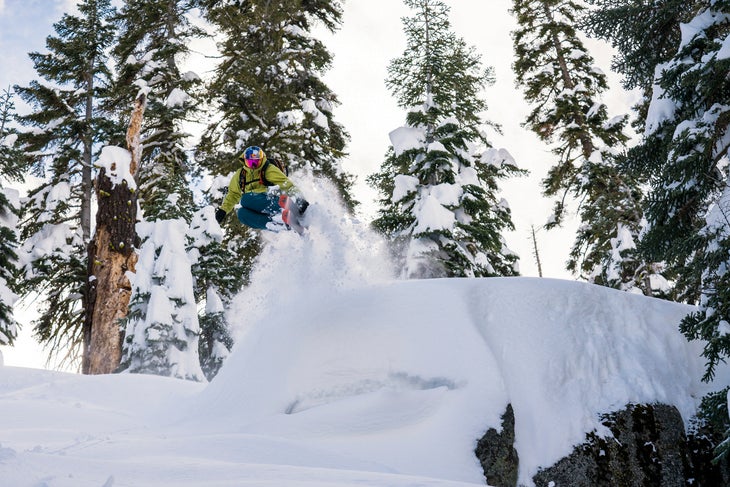Products You May Like
Receive $50 off an eligible $100 purchase at the Outside Shop, where you’ll find gear for all your adventures outdoors.
Sign up for Outside+ today.
Stuck in a skills rut? Check out SKI’s online education courses on Outside Learn, home to hundreds of video tutorials. Get expert tips on how to level up from industry pros like Glen Plake, Wendy Fischer, Daron Rahlves, and more.
There’s no question that threading the perfect line through the trees is one of the most magical experiences one can have on skis. Passing from the trail into the trees can feel like entering some sort of Narnia of snow-covered conifers and infinitely creative line choices. Yet perfecting the art of tree-skiing is as elusive as it is rewarding.
We asked Aspen, Colo.–based professional ski instructor Jennifer Weier about what it takes to master the craft. Weier is a PSIA-certified ski instructor and badass nurse who co-taught—alongside pro skier Daron Rahlves—SKI’s Find Your Line: How to Ski Trees.
Sneak Peek: Outside Learn’s How to Ski Trees online course
SKI: What is the first tip you would give to someone who wants to get into tree-skiing but doesn’t know where to start?
Jennifer Weier: Tree skiing requires being able to make a variety of short turns. So practice making a variety of different short turns at different speeds, and then find someone (instructor, ski patrol, resort host or trusted local) to help you find the most user-friendly trees to go explore. Take it slow, make your first run more of recon, and then return and slowly build your confidence and speed when you become familiar and comfortable.

SKI: What is the most common mistake you see people make while trying to ski the trees?
Weier: When skiers get nervous, we go into survival mode and do lots of interesting things to get our skis to turn across the hill. Very commonly skiers end up with too much of their weight on the inside ski in these situations. This causes all kinds of challenges in speed control and ski maneuverability. So, as a rule, work to stay balanced over the outside ski through the whole turn; this will help you be balanced over your skis in a way that you will have more options of how you can move your body and turn your skis. More options equal more confidence, and ultimately more fun.
SKI: How important is it to be on the right pair of skis if you want to start tree-skiing?
Weier: It is very important to be on a ski that you feel comfortable on and that you are able to easily make a variety of turn shapes on. Choose a ski that feels nimble, and that matches the snow conditions you will find in the trees. The most important thing is how YOU feel on the ski, and different people will prefer different skis based on their body, technique, and personal style and ability. The last thing you want to worry about when skiing a tight or challenging line is how your ski is going to respond.
Related: Best All-Mountain Skis of the Year
SKI: What are the ideal snow conditions for tree-skiing?
Weier: For me, either fluffy powder, chopped loose snow, or chalky winter snow with some bumps are my favorite conditions for skiing trees. If you are working on becoming more comfortable in trees, you may find that the trees will be most approachable in snow conditions that you are comfortable skiing in. There is no need to double challenge yourself by adding challenging snow to a challenging environment. Keep in mind, a powder day in the trees is magical with a capital M. So, work on your powder skills because this is something you don’t want to miss out on.
SKI: Where is your favorite place to ski trees and why?
Weier: Honestly, any trees where I can go and follow a local are my favorite. Locals (including patrol, ski instructors) know where to go with the best conditions, often taking me places I would be unlikely to find on my own. But I’ve got to say, I love skiing the trees at Aspen Highlands off the Deep Temerity lift. The options of trees in that area are incredible, there are some steep areas, long sections of moguls, and some more glazed areas. I keep finding new lines and routes each year. But beware, there is no easy way out. Once you drop in, you are in and going to the bottom (there is one catwalk escape route, but it can be sporty at times).
SKI: What can one learn by watching a pro like Daron Rahlves (or yourself) ski the trees?
Weier: When watching, or better yet following, a pro skier in the trees, you get to see the artistry of tree skiing. This is something that is really can’t be easily described, but that is easily observed. But when watching or following, you can easily see how the pro interprets the line and snow, mixing up turn shapes and styles, finding features and lines that you may not have seen. How the skier combines their skill, confidence, and adventurous nature creates a flow to their skiing that really must be seen to begin to understand.
Find Your Line: How to Ski Trees is a five-part online education series designed to provide tips, tricks, and techniques for gaining confidence in the glades. Through video instruction, exercises you can do on your own, risk-management advice, and more, you can learn to skis safely and with confidence and style. Find out more about Outside Learn here.
